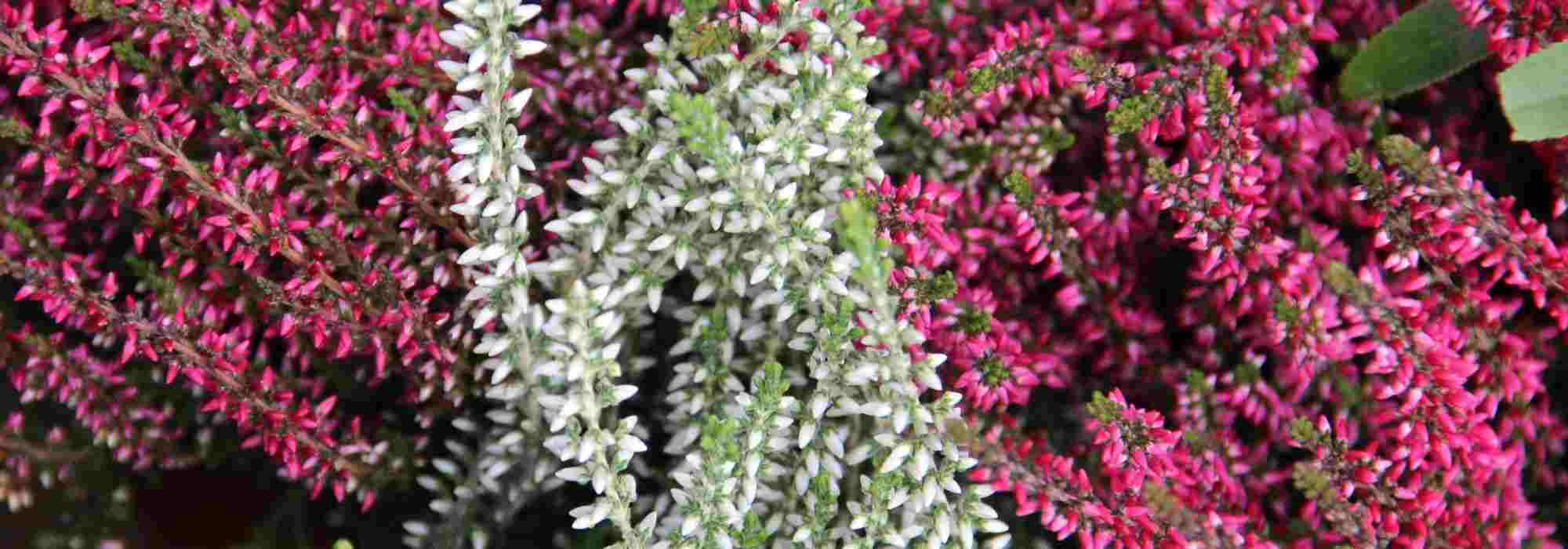
How to choose a heather?
Buying guide and criteria to find the ideal variety
Contents
Heathers are shrubs that are perennial and evergreen, offering lovely bell-shaped flowers that are highly melliferous. The majority of varieties adapt well to both open ground and pot cultivation.
Flower colours and shapes, flowering periods, decorative foliage, sizes, and uses in the garden… Here are our tips for finding the ideal variety of heather based on these different criteria.
And to successfully cultivate heather, we invite you to discover our article: Heathers: planting, pruning, and maintaining
Based on the colour of the flowers
The colour palette of heathers is less extensive than that of other plants, but this does not prevent it from offering varieties for all tastes. From the most subdued shades to the most original, from the brightest to the softest, you are sure to find a colourful heather that suits you.
Pink Heathers
Certainly the most common colour and the first that comes to mind when we think of heather flowering: pink! It comes in various very subtle shades, from the lightest to the darkest.
Among the paler varieties, we can mention summer heather Calluna vulgaris ‘Spring Torch’, with flowers of a cream-pink hue. The winter heather Erica x darleyensis ‘Ghost Hills’ has an evolving colour, first pale pink, then mauve. ‘Winter Belles Phoebe’ produces salmon-pink bell-shaped flowers.
In slightly cooler shades, ‘Darley Dale’ offers a pink-lilac, the Christmas bush Erica canaliculata a pink-violet, and Calluna vulgaris ‘Silver Knight’ a lavender-pink.
Erica darleyensis ‘Eva Gold’ offers a magnificent magenta pink, just like ‘Winter Belles Tylou’.
Original, the Corsican heather Erica terminalis flowers in pink, before taking on mauve shades and turning to coppery orange.
Finally, the summer heather Calluna vulgaris ‘Allegro’ produces bright pink flowers leaning towards red : a particularly dynamic colour. This is also the case for Erica x darleyensis ‘Kramer’s Rote’, which brings a lot of cheer during the winter season.
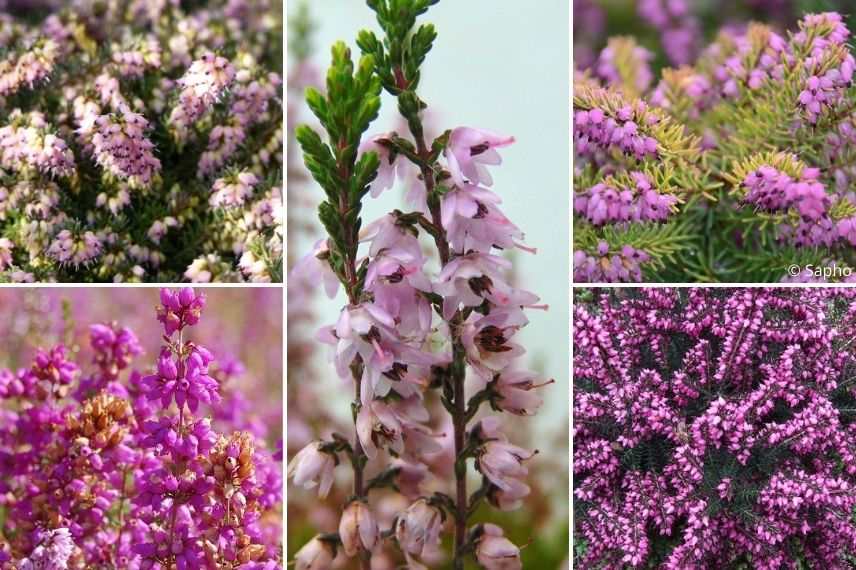
Erica darleyensis ‘Winter Belles Phoebe’, Calluna vulgaris ‘Spring Torch’, Erica ‘Eva Gold’, Calluna vulgaris ‘Allegro’ and Erica x darleyensis ‘Kramer’s Rote’ (photo Wikipedia)
White Heathers
White-flowering heathers adapt to all types of gardens. Their neutral colour allows them to be combined with any other colour, bringing lightness and a true touch of brightness.
Summer heathers Calluna vulgaris ‘Sandy’ or ‘Alba’ are adorned with beautiful pure white bell-shaped flowers. A bit larger than their counterparts and exuding a light honey fragrance, the arborescent heather ‘Great Star Le Vasterival’ offers a porcelain white tinged with pink.
The white flowering of winter heathers brightens the cold season, at a time when few plants are in bloom. They can sometimes even be covered in snow, blending perfectly into the winter landscape. Among them, we can mention Erica darleyensis ‘White Perfection’, ‘Winter Belles Katia’ and Erica carnea ‘Springwood White’, all producing immaculate white bell-shaped flowers, only highlighted by small brown stamens. Meanwhile, the bell-shaped flowers of Erica darleyensis ‘Silberschmelze’ offer a white with discreet silver reflections.

Erica darleyensis ‘Springwood White’, Erica darleyensis ‘Silberschmelze’, Calluna vulgaris ‘Sandy’, Erica ‘Great Star Le Vasterival’ and Erica darleyensis ‘Winter Belles Katia’
Other Heather Colours to Discover
In less common and surprising colours, let’s start with the heather Eric nana ‘Limoncello’, a variety with incredible tubular flowers that are first yellow-green, then turning lemon yellow. A true sun in the garden!
On the other hand, the heather Calluna vulgaris ‘Winter Chocolate’ offers foliage in beautiful warm tones heralding autumn, which contrasts wonderfully with its surprising purple to violet flowers.
Another little treasure: summer heather Calluna vulgaris ‘Marlies’ with its unmistakable ruby red flowers. A true carpet of vegetation in a colour that is uncommon for heathers.

Calluna vulgaris ‘Marlies’ (photo Ole Husby)
Read also
Heathers: planting, pruning and careBased on the shape of the flowers
Most heathers feature adorable little bell-shaped flowers, with stamens that may slightly protrude. They are grouped in long clusters along the branches.
The Irish heath Daboecia cantabrica and its white variety ‘Alba’ stand out with their large, trailing bell-shaped flowers, measuring 8 mm long and 3 to 4 mm in diameter. This is also true for the ‘Winter Belles’ varieties like ‘Lucie’, whose bells are almost twice the size of those of classic varieties.
The South African cultivars, such as the Cape heath Erica verticillata or the heath Eric nana ‘Limoncello’, feature tubular corolla flowers measuring 2 cm in length, forming generous bouquets that almost cover the branches.
Calluna vulgaris ‘Marleen’ produces bells that have the unique characteristic of remaining closed. Their colour evolves from white punctuated with reddish-purple to purple.
Finally, the summer heath Calluna vulgaris ‘H.E Beale’ offers rare double flowers, forming tiny pale pink pom-poms.

Daboecia cantabrica (photo Wikipedia), Erica verticillata (photo Andrew Massyn), Calluna vulgaris ‘Marleen’ and Calluna vulgaris ‘H.E Beale’
Discover other Heathers
View all →Available in 0 sizes
Available in 0 sizes
Available in 0 sizes
Available in 1 sizes
Available in 3 sizes
Available in 2 sizes
Available in 2 sizes
Available in 3 sizes
Available in 2 sizes
Available in 1 sizes
Depending on the fragrance
Heathers are melliferous plants that inevitably attract pollinating insects. Some varieties are also delicately scented, releasing subtle notes of honey. This is the case with the arborescent heather ‘Great Star Le Vasterival’, Corsican heather, and the Christmas shrub heather, whose sweet fragrance is reminiscent of certain gentle soaps.
Read also
Pruning heather: when and how?According to the flowering period
What is convenient about heathers is that many varieties indicate their flowering period directly in their name: we can indeed distinguish summer heathers, which bloom in the beautiful season, from winter heathers, which logically flower around the cold season.
Winter heathers of the genus Erica bloom from autumn to early spring. This is the case, for example, with ‘Kramer’s Rote’, ‘Silberschmelze’, and ‘Winter Belles Tylou’, which bloom between November and March. ‘Spring Surprise’ lives up to its name, as it offers a long and late flowering in spring, from March to May.
Summer heathers, on the other hand, are generally in bloom between August and October, such as ‘Alba’, ‘Silver Knight’, or ‘Marleen’. Cape heather also blooms in summer. Calluna vulgaris ‘Sandy’ is one of the latest, with its flowering occurring between September and November.
For shrubby heathers, flowering occurs practically in every season depending on the varieties, from late winter to summer: between April and May for ‘Limoncello’, between March and May for the arborescent heather ‘Great Star Le Vasterival’, between July and August for the Corsican heather,…
By combining several varieties of heathers, it is therefore possible to enjoy their flowering almost all year round!
→ Read also: Summer heather, the most beautiful varieties
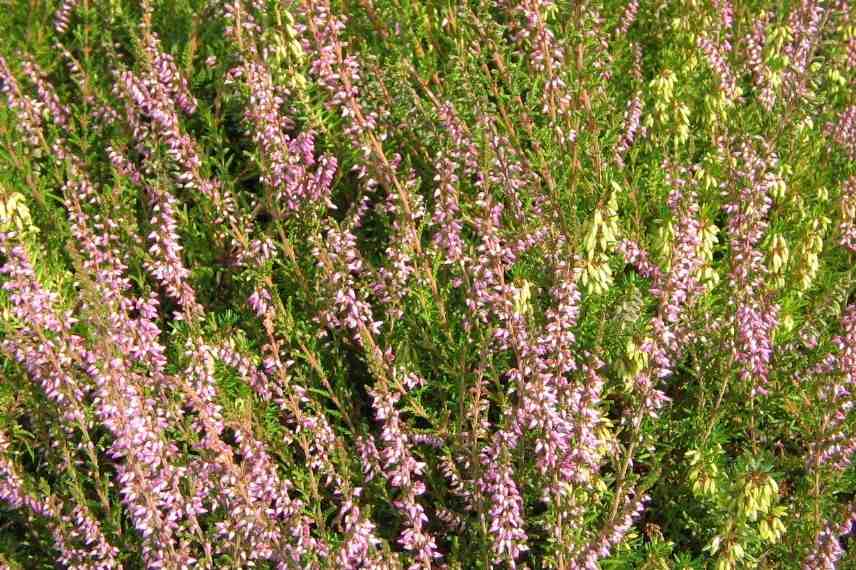
Calluna vulgaris ‘Marleen’ (photo Wikipedia)
According to its foliage
Heathers have the advantage of offering evergreen foliage, naturally decorative in all seasons, even during winter. The leaves are generally fine, lanceolate in shape, and of a medium to dark green.
However, some varieties stand out by offering different shades, even foliage with changing colours.
- Calluna vulgaris ‘Sandy’ features an original golden foliage
- ‘Silver Knight’ produces villous leaves with silvery reflections, reddening in the cold
- ‘Winter Chocolate’ offers small cypress-like foliage that is golden yellow to bronze, turning brownish-red in winter
- ‘Allegro’ produces leaves that change from green to bronze-purple in autumn, just like ‘Dark Beauty’
- Erica carnea ‘Jenny Porter’ has dark green foliage with cream tips in spring
- In addition to its flowering, Erica (x) darleyensis ‘Silberschmelze’ warms winter with its reddening foliage in the cold; its leaves are light green maculate with cream in spring, then dark green in summer
- The cold also changes the leaf colour of ‘Kramer’s Rote’, which shifts from green to bronze-copper, just like ‘Ghost Hills’
- ‘Eva Gold’, on the other hand, changes from light spring green to summer yellow-gold, before donning dark green in winter

Golden foliage of Calluna vulgaris ‘Sandy’ and greyish foliage of Calluna vulgaris ‘Silver Knight’
According to its size and shape
While most heathers are small in size, there are also larger varieties. In terms of shape, heathers are quite diverse, as they can have a spreading or bushy, compact or flexible habit.
Heathers for Pots
Due to their slow growth and small development, most heathers can be grown in pots or containers, to be placed on a windowsill, balcony, or terrace.
Consider, for example, Erica darleyensis ‘Eva Gold’, which forms an adorable compact ball of 40 cm in all directions, or Daboecia cantabrica ‘Alba’, which has the same dimensions but a more flexible, cottage-like appearance.
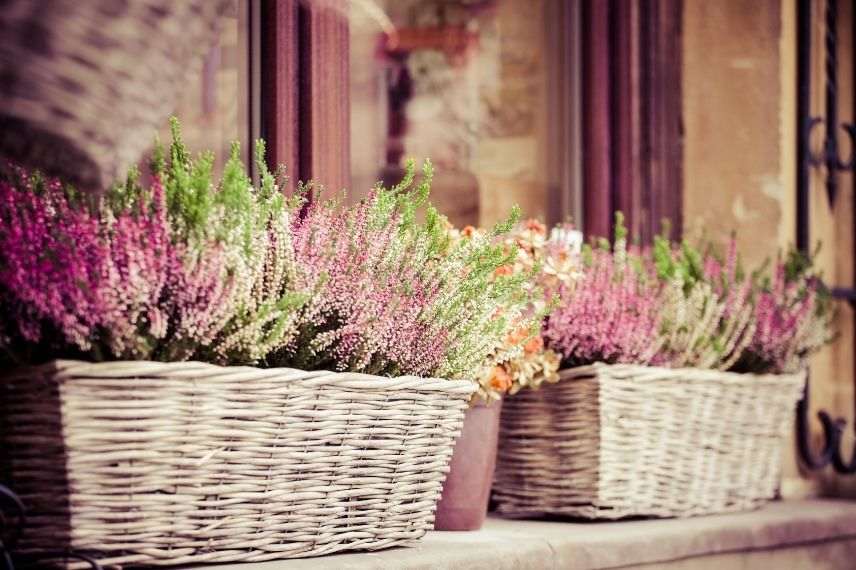
Groundcover Heathers
These heathers, with wider than tall silhouettes, are perfect for dressing rockeries, slopes, front borders of flower beds, or edges.
Summer heathers ‘Alba’ and ‘Marleen’ (30 cm in height and 50 cm in spread) or winter heathers ‘White Perfection’ and ‘Ghost Hills’ (40 cm in height and 70 cm in spread). More imposing, the arborescent heather ‘Great Star Le Vasterival’ will also form a beautiful white carpet with its 1.5 meters in height and 2 meters in spread.

Shrubby Heathers
Classic heather varieties measure about 30 to 50 cm in height. However, there are so-called “shrubby” varieties, which are more vigorous and larger, measuring from 1 to several meters in height. These large heather varieties can be grown in isolation, in a free shrub hedge, or as a backdrop in a flower bed.
This is the case with the western heather Erica mediterranea, a beautiful bushy plant of 1.2 meters in all directions, as well as Erica canaliculata, a large heather of 1.5 meters in height and spread, perfect for mild and humid climates.
According to its growing conditions
Limestone Tolerance
Heathers thrive in poor, well-drained soils that do not retain water. They also prefer acidic pH soils. To determine if heathers can be planted in your garden, feel free to test our Plantfit application, which will recommend the most suitable plants for your growing conditions.
However, some heathers exhibit a slightly higher tolerance to limestone than their counterparts. They can thus withstand a slightly more alkaline pH. The ‘Darley Dale’ winter heather or ‘Silberschmelze’, the Corsican heather or the western heather Erica mediterranea are among these candidates.
If your soil is particularly calcareous, we remind you that growing heathers in pots is very simple and allows you to enjoy the aesthetic benefits of these shrubs in any garden!
Hardiness
The hardiness of heathers varies by cultivar, but is often around -15°C to -20°C. Winter heathers obviously have good hardiness, allowing them to withstand frost and snow, but summer heathers are also cold-tolerant.
Conversely, due to their origins, the larger varieties of shrubby heathers are generally less hardy (–5° to -10°C). They should therefore be reserved for mild Mediterranean or Atlantic coastal climates.

- Subscribe!
- Contents
































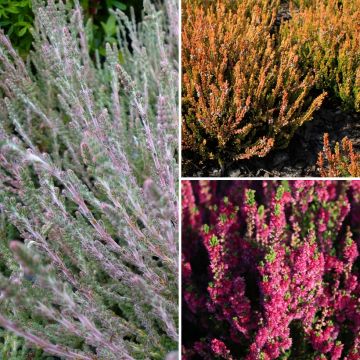
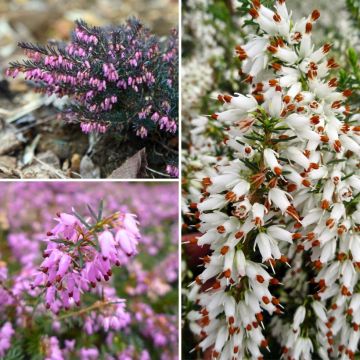



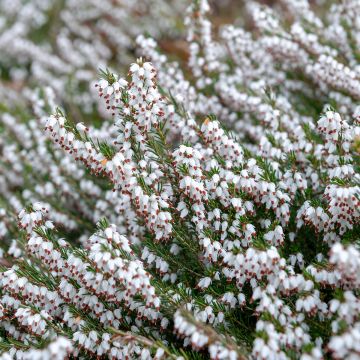

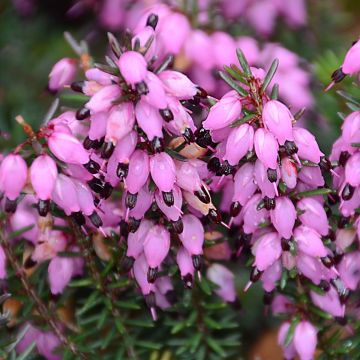
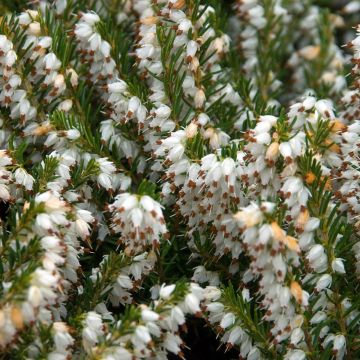
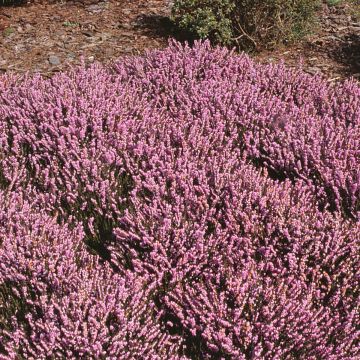
Comments